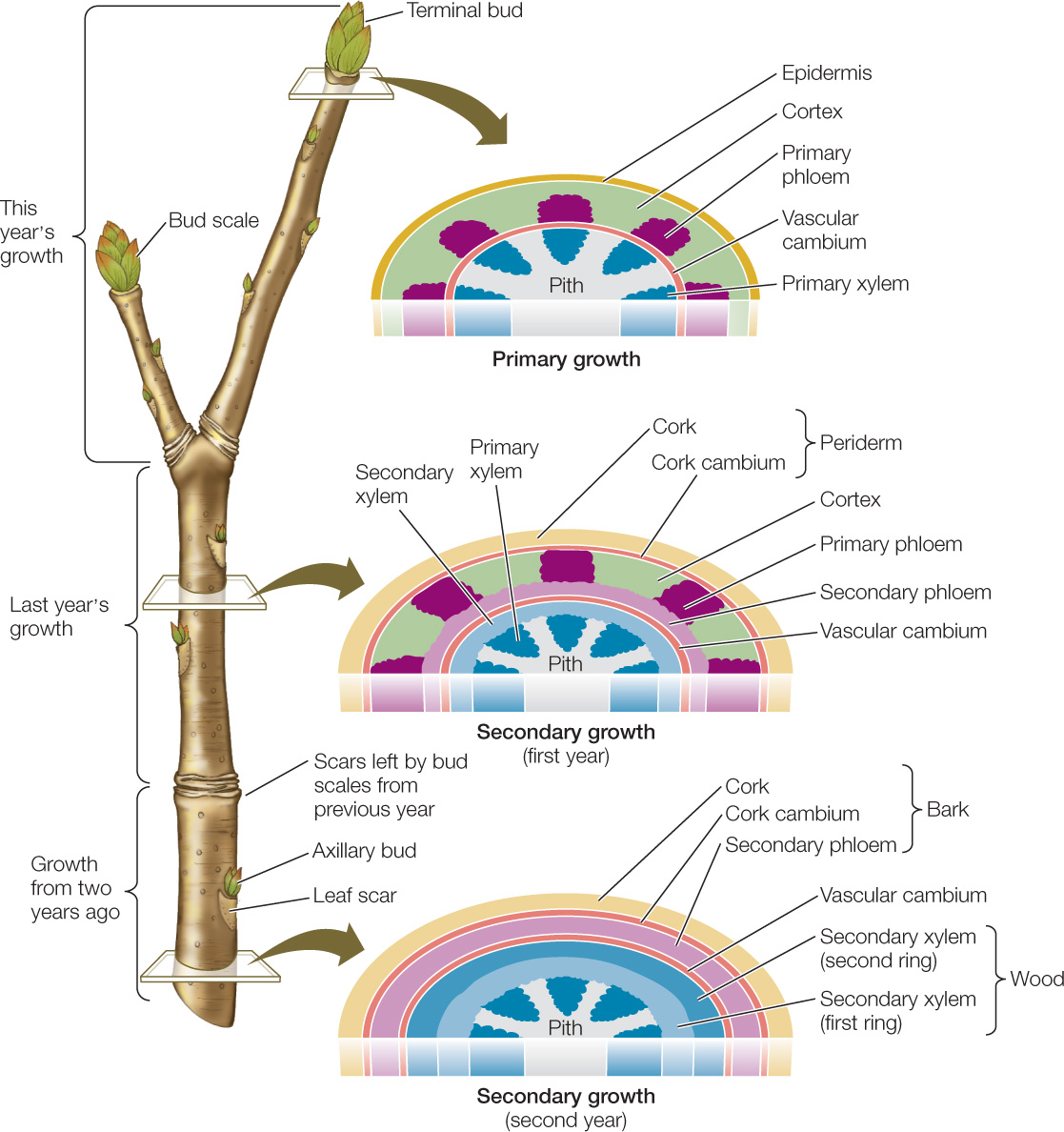CONCEPT24.3 Many Eudicot Stems and Roots Undergo Secondary Growth
As we mentioned earlier, the roots and stems of some eudicots develop a secondary plant body, the tissues of which we commonly refer to as wood and bark. These tissues are derived by secondary growth from the two lateral meristems:
- The vascular cambium produces cells that make up secondary xylem (wood) and secondary phloem (inner bark).
- The cork cambium produces mainly waxy-walled protective cells. It supplies some of the cells that become outer bark.
Although secondary growth occurs in broadly similar ways in both roots and stems, the details differ. We focus on stems in our discussion here.
Each year, deciduous trees lose their leaves, leaving bare branches and twigs in winter. These twigs illustrate both primary and secondary growth (FIGURE 24.14). The apical meristems of the twigs are enclosed in buds protected by bud scales. When the buds begin to grow in spring, the scales fall away, leaving scars, which show us where the bud was and allow us to identify each year’s growth. The woody portions of the twig are the product of primary and secondary growth. Only the buds and the newest growth from the apical meristem consist entirely of primary tissues.

In the stem, the vascular cambium is initially a single layer of cells lying between the primary xylem and the primary phloem within the vascular bundles. A stem increases in diameter when the cells of the vascular cambium divide, producing secondary xylem cells toward the inside of the stem and secondary phloem cells toward the outside (see Figure 24.14). Each year the vascular cambium produces a new layer of secondary xylem and a new layer of secondary phloem, further increasing the diameter of the stem.
The successive layers of secondary xylem, which constitute the wood, all continue to conduct water and minerals for many years. A given year’s secondary phloem, however, is active in transport of sugars for only that year; the sieve tube elements and companion cells are crushed as the next year’s layer of secondary phloem is formed and pushes outward.
The cork cambium initially forms just inside the epidermis (see Figure 24.14). This meristematic tissue produces layers of cork, a protective tissue composed of cells with thick walls waterproofed with suberin. The cork cambium and the cork constitute a secondary dermal tissue called periderm. Once the periderm forms, the epidermis flakes off, leaving the cork as the outmost layer. The cork prevents excessive water loss and protects the plant from herbivores and pathogens.
534
As secondary growth of a stem continues, the expanding vascular tissue stretches and breaks the outer layers of the cortex and the initial periderm, which ultimately flake away. A new cork cambium arises from the underlying secondary phloem and produces a new periderm. The periderm and the secondary phloem—that is, all the tissues external to the vascular cambium—constitute the bark.
Cross sections of most tree trunks (which are mature stems) in temperate-zone forests reveal annual rings in the wood (FIGURE 24.15), which result from seasonal changes in environmental conditions. In spring, when water is relatively plentiful, the tracheids or vessel elements produced by the vascular cambium tend to be large in diameter and thin-walled. Such wood is well adapted for transporting large quantities of water and mineral nutrients. As water becomes less available in summer, narrower cells with thicker walls are produced, which make this summer wood darker and sometimes more dense than the wood formed in spring. Thus each growing season is recorded by a clearly visible annual ring. Trees in the moist tropics do not experience these seasonal changes, so they do not lay down such obvious regular rings. In temperate-zone trees, variations in temperature or water supply during the growing season can sometimes lead to the formation of more than one “annual” ring in a single year.

Only eudicots and other non-monocot angiosperms, along with many gymnosperms, have a vascular cambium and a cork cambium and thus undergo secondary growth. The few monocots that form thickened stems—palms, for example—do so without secondary growth. Palms have a very wide apical meristem that produces a wide stem, and dead leaf bases add to the diameter of the stem. Almost all monocots grow in essentially this way, as do other angiosperms that lack secondary growth.
CHECKpointCONCEPT24.3
- Compare primary and secondary growth, creating a table with the following headings: the plant groups that undergo them; the organs that are involved during the plant life cycle; the meristems that are involved; and the products of the meristems.
- Why are annual rings used to determine the age of a tree trunk?
Natural selection has acted on the plant body plan to produce a remarkable diversity of plant forms. In the next section we will see how artificial selection by humans on the plants that provide us with food and fiber has greatly altered plant form as well.